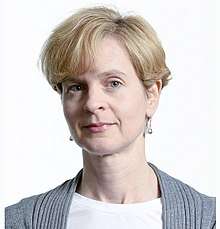Wendy Taylor (physicist)
Wendy Taylor is an Experimental Particle Physicist at York University and a former Canada Research Chair. She is the lead for York University's ATLAS experiment group.
Wendy Taylor | |
|---|---|
 | |
| Born | 20 February |
| Alma mater | University of British Columbia University of Toronto |
| Known for | CP violation Magnetic monopole |
| Scientific career | |
| Institutions | York University Stony Brook University |
| Thesis | (1999) |
| Doctoral advisor | Pekka Sinervo |
Education
Taylor graduated from the University of British Columbia with Bachelors of Science in Physics in 1991.[1] As an undergraduate, she worked at TRIUMF, working on rare kaon decay.[1] She completed her graduate studies at the University of Toronto, where she earned a PhD under the supervision of Pekka Sinervo in 1999.[2][3] She worked on fragmentation properties of the bottom quark.[4] She worked at Stony Brook University as a postdoctoral fellow.[5][6] She worked on Fermilab's D0 experiment, building electronics to detect bottom quark particles in real time.[1][7]
Research
Taylor's research focuses on the magnetic monopole. To do this, she is using the ATLAS detector at CERN.[8][9] Her lab concentrated on the development of firmware for the transition radiation tracker within the ATLAS experiment.[10] She is motivated by predictions from Grand Unified Theory, the observation of quantised charge and potential to reinforce the symmetry in Maxwell's equations.[11]
.jpg)
Taylor spent five years working at the Tevatron particle accelerator. She was concerned when it lost government funding in 2011.[12] Whilst working at the Fermilab Tevatron particle accelerator, Taylor identified CP violation in the decay of bottom quarks, which could contribute to the dominance of matter in the universe.[13] The rate at which she detected CP violation was two-orders of magnitude larger than that predicted by the Standard Model of particle physics.[14][15]
She joined York University in 2004, where she was one of two women in the department.[16] She held a Canada Research Chair between 2004 and 2014.[16]
Taylor is a member of the American Physical Society and the Particle Physics Division of the Canadian Association of Physicists.[17][18]
References
- ExpertFile. "Wendy Taylor Professor of Physics, Department of Physics and Astronomy - Expert with York University | ExpertFile". expertfile.com. Retrieved 2018-02-19.
- "Former Graduate Students — Department of Physics". www.physics.utoronto.ca. Retrieved 2018-02-19.
- "Pekka K. Sinervo, FRSC — Pekka Sinervo". sites.physics.utoronto.ca. Retrieved 2018-02-19.
- Taylor, Wendy Jane (1999). "A measurement of b-quark fragmentation fractions in proton-antiproton collisions at 1.8 TeV". Ph.D. Thesis: 4679. Bibcode:1999PhDT........78T.
- Taylor, Wendy (2003-03-13). "The Physics of b Quarks" (PDF). Stony Brook University. Retrieved 2018-02-19.
- ORCID. "Wendy Taylor (0000-0002-6596-9125) - ORCID | Connecting Research and Researchers". orcid.org. Retrieved 2018-02-19.
- Martin., Erdmann (2003). Hadron Collider Physics 2002 : Proceedings of the 14th Topical Conference on Hadron Collider Physics, Karlsruhe, Germany, September 29-October 4,2002. Müller, Thomas. Berlin, Heidelberg: Springer Berlin Heidelberg. p. 232. ISBN 3642555241. OCLC 840292012.
- "Many theories predict existence of magnetic monopoles, but experiments have yet to see them". Retrieved 2018-02-19.
- "Search for magnetic monopoles in $sqrt{s}=7$~TeV $pp$ collisions with the ATLAS detector". atlas.web.cern.ch. Retrieved 2018-02-19.
- "Faculty Members - Wendy Taylor". York University. Retrieved 2018-02-19.
- Taylor, Wendy. "The Search for Magnetic Monopoles at the ATLAS Detector" (PDF). Retrieved 2018-02-19.
- "Fermilab's Tevatron collider to shut down this year". Excalibur Publications. 2011-06-18. Retrieved 2018-02-19.
- "A New Clue In The Antimatter Mystery". The Square. 2010-06-02. Retrieved 2018-02-19.
- "McGill Physics: CHEP seminars". www.physics.mcgill.ca. Retrieved 2018-02-19.
- "Heavy Flavour Physics News from the Tevatron Wendy Taylor for the CDF and D Ø Collaborations APS/AAPT 2010, Washington, DC, February 13-16, ppt download". slideplayer.com. Retrieved 2018-02-19.
- Horn, Michiel (2010). York University : the way must be tried. Pietropaolo, Vincenzo., York University (Toronto, Ont.), Canadian Electronic Library. Montreal [Que.]: Published for York University by McGill-Queen's University Press. ISBN 978-0773577244. OCLC 759157045.
- "RASC Mississauga: Antimatter: From the Subatomic to the Cosmological Scales | RASC Toronto". rascto.ca. Retrieved 2018-02-19.
- "Particle Physics Division (PPD) - Canadian Association of Physicists". Canadian Association of Physicists. Retrieved 2018-02-19.